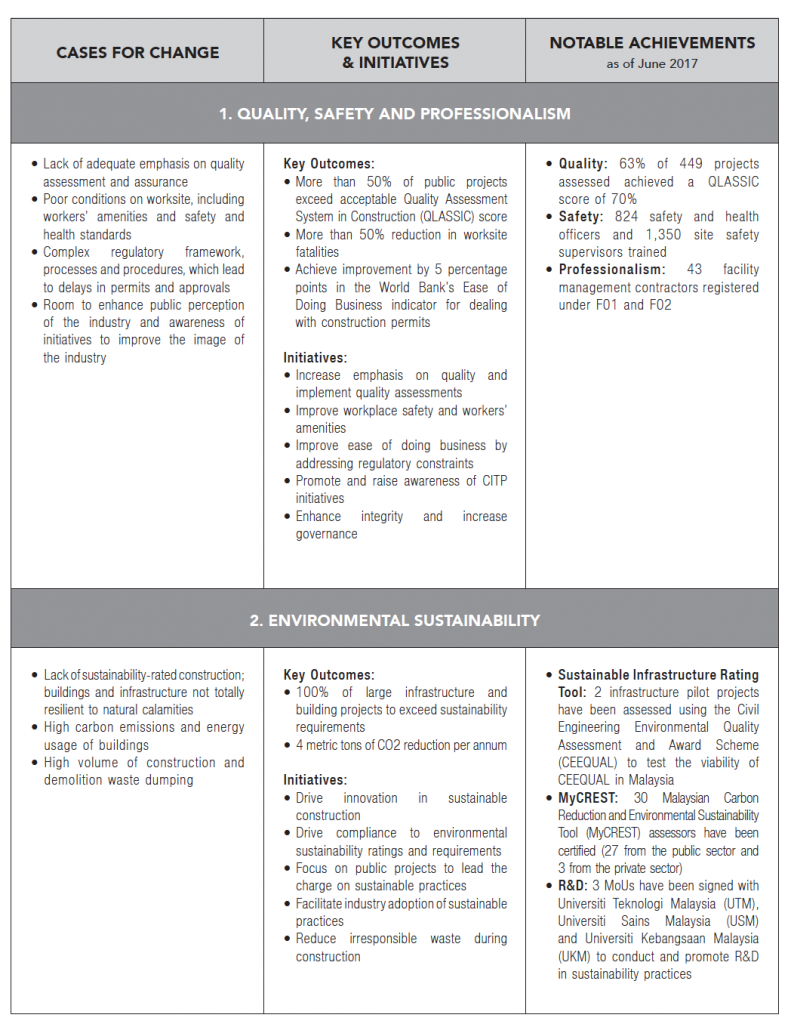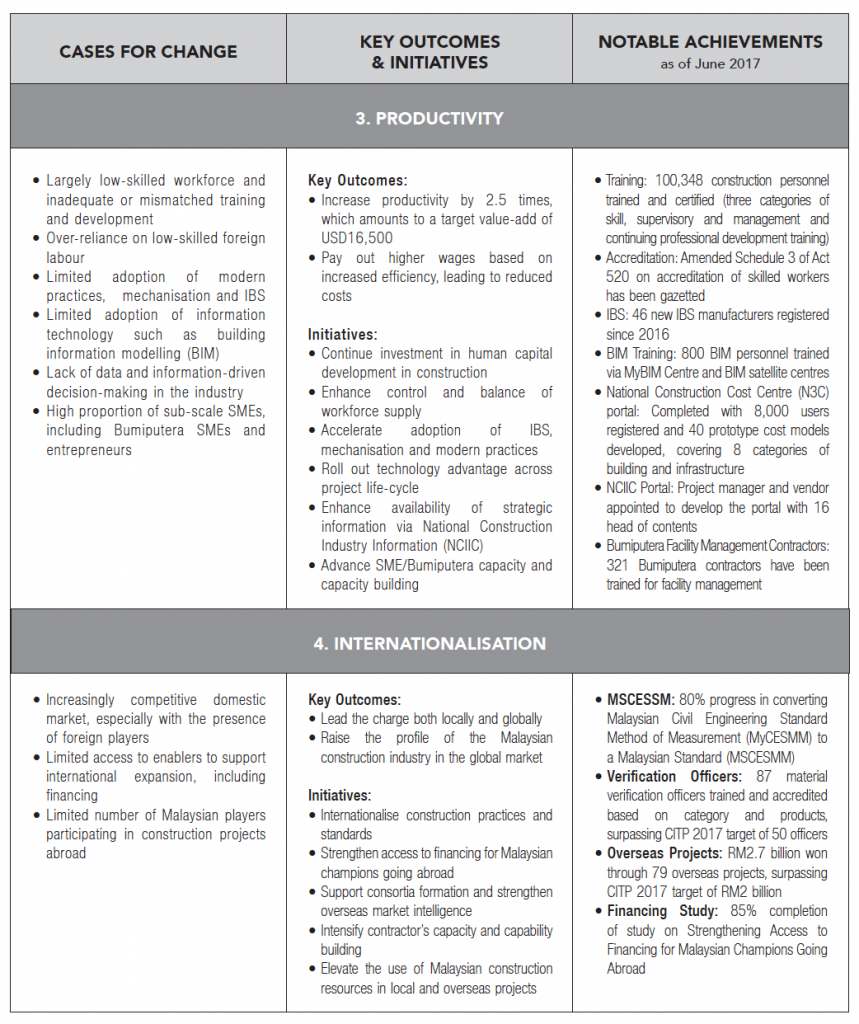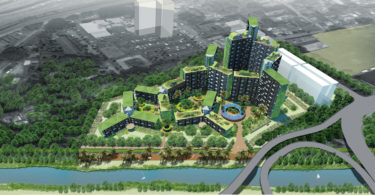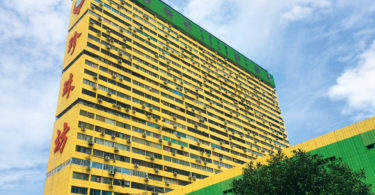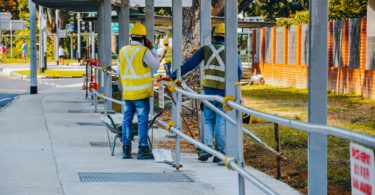The Malaysian construction industry is one of the key sectors of the country. The industry serves as a catalyst for the development of 120 industries and has consistently outperformed the national gross domestic product (GDP) since 2012.
In fact, the industry had achieved an astounding growth rate of 11.1 per cent throughout the period under the 10th Malaysia Plan, from 2011–2015, surpassing the performance of all other economic sectors in the country. In 2012, the construction industry registered a historical 18.1 per cent growth, as compared to the national GDP growth of 5.5 per cent.
This growth trend continued right up to 2016, when the industry grew by 7.4 per cent, once again outperforming the overall national GDP growth of 4.2 per cent.
Under the 11th Malaysia Plan (2016–2020), the construction industry is expected to expand by 10.3 per cent per annum throughout the Plan period.

THE YEAR IN REVIEW
Despite challenging economic conditions in 2017, the construction industry in Malaysia has been performing credibly. In fact, in the third quarter of 2017, the value of work done by the construction sector registered a 8.1 per cent growth year-on-year to record RM34.5 billion, according to the Department of Statistics, Malaysia.
This was driven by positive growth in all sub-sectors, namely civil engineering (18.0 per cent), special trades activities (10.5 per cent), non-residential buildings (2.8 per cent), and residential buildings (1.6 per cent).
In terms of contributions, the civil engineering sub-sector continues to dominate with a 38.1 per cent share, followed by non-residential buildings (29.2 per cent), residential buildings (28.2 per cent) and special trades activities (4.5 per cent).
THE YEAR AHEAD
We welcome the Prime Minister’s Budget 2018 announcement, which will boost the construction industry and is expected to sustain growth at a rate of 7.5 per cent. The allocation of RM2.2 billion for public housing projects such as 1Malaysia People’s Housing Programme (PR1MA), in addition to major InfraRakyat projects, such as the Mass Rapid Transit Line 3, Pan Borneo Highway and East coast Rail Link, will spur the construction industry, which in turn contributes towards the country’s economic growth.
In particular, we commend the government’s move to make it mandatory for all private projects to use industrialised building systems (IBS) for projects valued at RM50 million or more in three years’ time, which is also one of the key performance indicators under the Construction Industry Transformation Programme’s (CITP) Productivity strategic thrust. In this area, the government has announced an allocation of RM2.5 billion over the period of two years in rebuilding schools through the IBS method.
Other interesting measures to note are:
• RM1 billion allocated for five main corridors, while the government develops the South Perak Region and Bukit Kayu Hitam duty-free zone, construction of port and industrial park in Tok Bali, Kelantan, and access road to Baleh Dam, Sarawak;
• RM95 million to upgrade and construct jetties, as well as dredge river estuaries; and
• RM83.5 million to construct infrastructure for the first phase of the Digital Free Trade Zone in Aeropolis, KLIA.
Next year, 2018, will certainly be an exciting year for the construction industry that, we at CIDB, look forward to. With the third year of CITP implementation commencing, we will be ramping up on the implementation of the transformative initiatives to propel the industry to be a modern, high quality and safe, productive and sustainable sector by 2020.
CONSTRUCTION INDUSTRY TRANSFORMATION PROGRAMME
To ensure that Malaysia’s construction industry’s growth is sustained for the long run, we recognise that it is important to transform the construction industry to be a modern, highly productive and sustainable sector.
In view of that, the Construction Industry Transformation Programme (CITP) 2016–2020 was introduced to guide the transformation of the industry through four strategic thrusts, namely:
• Quality, Safety and Professionalism;
• Environmental Sustainability;
• Productivity; and
• Internationalisation.
Launched in 2015, the CITP is a national transformation programme that sets strategic outcomes and milestones to develop Malaysia’s construction sector into a world-class industry that is able to compete locally as well as internationally. More than 150 industry stakeholders were involved in the development of the CITP, and implementation is driven by CIDB through the leadership of the Ministry of Works.
There are a number of issues and challenges that need to be addressed to truly transform the construction industry towards becoming one that is highly productive, environmentally sustainable, prioritises safety and quality standards, and on par with globally competitive players.
The CITP has identified these key issues and challenges as Cases for Change, with relevant initiatives put in place via the four strategic thrusts to address them (as laid out in Table 1).
To ensure the construction industry transforms as envisioned in the CITP, it is imperative for the public and private sector to work hand-in-hand on the outlined initiatives.
This is where coordination and strong buy-in across all stakeholders are necessary. Collaboration is a key enabler during the development of the CITP and will continue to be as an integral part in its implementation. Only by doing so can we achieve a complete transformation of the industry by 2020.
 DATUK IR AHMAD ’ASRI ABDUL HAMID
DATUK IR AHMAD ’ASRI ABDUL HAMID
Datuk Ahmad ’Asri was appointed chief executive of the Construction Industry Development Board (CIDB) Malaysia on 1 March 2016.
He was formerly senior general manager of CIDB’s Management Sector and has 16 years of experience in the organisation in various capacities, including heading the Levy Division, Business and Corporate Division, and the Development Sector.
Ahmad ’Asri has been in public service for more than 32 years, including as a mechanical engineer in the Public Works Department for 13 years. He also served as the president for the Professional Services Development Corporation (PSDC) for three years, where he was responsible for developing the capability and capacity of the professional services sector in facing with the challenges of liberalisation.

 Hong Kong
Hong Kong Singapore
Singapore Indonesia
Indonesia Tiếng Việt
Tiếng Việt ประเทศไทย
ประเทศไทย

